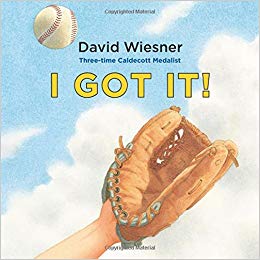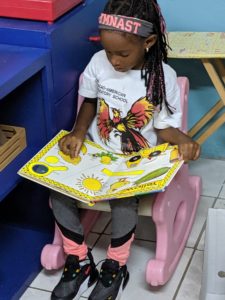Why I Picked It Up:
David Wiesner! The more Sherry and I blog, the more I realize how we each have our “go-to” authors. I love using wordless picture books in middle-grade classrooms to teach reading strategies and David Wiesner is the master!
Why I Finished It:
Truth time – I HATE baseball! On many levels, I can’t explain it, I just do. I threw a small party when all three of my boys chose not to play the sport anymore. I don’t mean to offend anyone, just sharing my truth #sorrynotsorry. That being said, this text surpasses baseball. It is really about all the feels of being part of a team, which I can definitely connect to. Insert any sport or just free play with friends at recess and the message is the same. You want to be included, you want to be good, but you’re nervous. You are worried about not being able to help, or worse yet, you’re worried about hurting the team. You’re concerned about reactions from teammates and how you feel personally. Then there is the other side, the success, the sense of belonging, and being encouraged by your friends. All of these feels are wrapped up in this book – WITHOUT any words! The story is told through the expressions on the kids’ faces, use of color, close-ups, and intricate graphics. The fact that I connected to the emotions in this book encouraged me to read it a few times!
Who I Would Give It To:
Definitely add I Got IT! to your wordless picture book piles in your classroom libraries. In addition, all those who enjoy baseball or being on a team would also enjoy this book. Teachers could use this book to help share how to behave at recess or on a team.
Integration Ideas:
Character Analysis – Making inferences and Writing Description
I Got It! is a wordless picture book, so you have to really pay attention to the illustrations and the events that are occurring to figure out how the characters feel and what they might do in reaction to events in the book. In reading, I have the students make inferences about how the characters are feeling. They explain the text evidence that they are using (e.g., the kids all covered their face with their palms when the boy missed the ball). Then they have to provide their background knowledge on this. Everyone’s background is different, they might say they cover their face when they’re scared and don’t want to see what’s happening, they might say they use a similar emoji when they are dumbfounded, etc. Then I have them make an inference as to how they are feeling in that moment and why. Use new vocabulary here. If the students say they are feeling upset that he missed the ball, you might say, “Yes, the kids are shocked and frustrated he missed the ball.”
Take this into their Writers’ Workshop. Choose one of the characters and write about what they are doing. This is a great “show not tell” lesson. Here’s an example of one of our fifth grader’s writing:
In complete disbelief, Jon tucked his glove under his arm and dropped his head into his hands. He stood like this for five minutes, shocked and saddened by his teammate’s miss.
After the class practices with this book, have them go to their own writing and visualize one of the characters or people and do the same for their own writing.
Reading Strategy: Retell
Retelling is an underutilized skill! It’s a crucial skill for basic comprehension. Wordless picture books are the perfect vehicle to introduce students to retelling. They can’t copy words in a book for a retell, they have to pay attention to what is happening and the order of events, and then they are forced to put their own words to express what happened. Check out this post on retelling as a strategy.
Reading Strategy: Making Connections –
Writing Strategy: Generating Ideas
As I expressed in the beginning, a big part of this book is how easy it will be for students to make text-to-self connections. Perhaps they are not baseball lovers (I hear you), but they have all had the emotions that come with these social contexts. Allow time for students to make those personal connections and discuss them.
Now that students have discussed these moments in their own life that connect with the story, they have just generated ideas to write about in their next personal narrative!









Leave a Reply